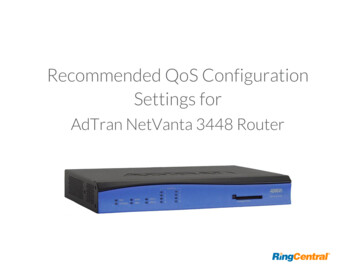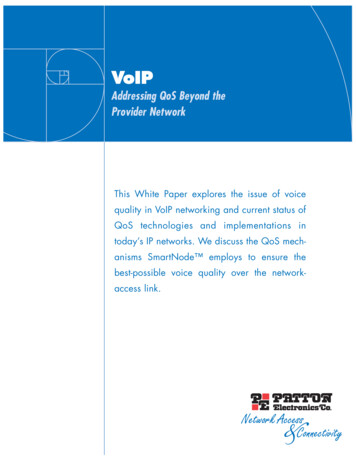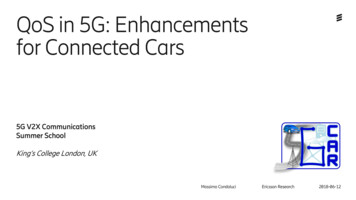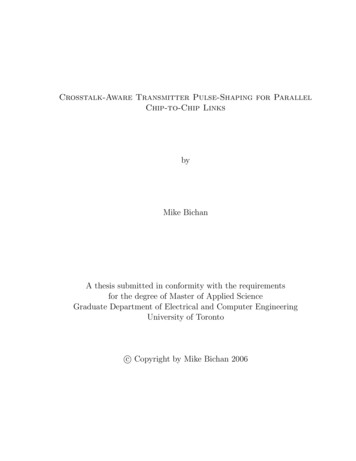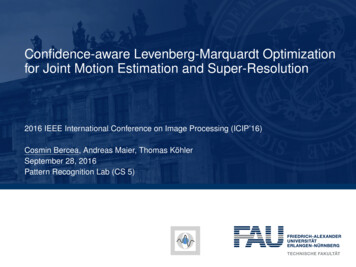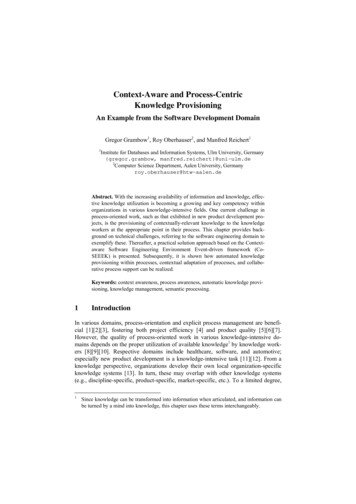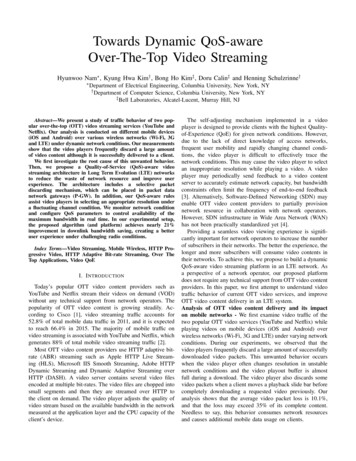
Transcription
Towards Dynamic QoS-awareOver-The-Top Video StreamingHyunwoo Nam , Kyung Hwa Kim† , Bong Ho Kim‡ , Doru Calin‡ and Henning Schulzrinne† Departmentof Electrical Engineering, Columbia University, New York, NYof Computer Science, Columbia University, New York, NY‡ Bell Laboratories, Alcatel-Lucent, Murray Hill, NJ† DepartmentAbstract—We present a study of traffic behavior of two popular over-the-top (OTT) video streaming services (YouTube andNetflix). Our analysis is conducted on different mobile devices(iOS and Android) over various wireless networks (Wi-Fi, 3Gand LTE) under dynamic network conditions. Our measurementsshow that the video players frequently discard a large amountof video content although it is successfully delivered to a client.We first investigate the root cause of this unwanted behavior.Then, we propose a Quality-of-Service (QoS)-aware videostreaming architecture in Long Term Evolution (LTE) networksto reduce the waste of network resource and improve userexperience. The architecture includes a selective packetdiscarding mechanism, which can be placed in packet datanetwork gateways (P-GW). In addition, our QoS-aware rulesassist video players in selecting an appropriate resolution undera fluctuating channel condition. We monitor network conditionand configure QoS parameters to control availability of themaximum bandwidth in real time. In our experimental setup,the proposed algorithm (and platform) achieves nearly 21%improvement in downlink bandwidth saving, creating a betteruser experience under challenging radio conditions.Index Terms—Video Streaming, Mobile Wireless, HTTP Progressive Video, HTTP Adaptive Bit-rate Streaming, Over TheTop Applications, Video QoEI. I NTRODUCTIONToday’s popular OTT video content providers such asYouTube and Netflix stream their videos on demand (VOD)without any technical support from network operators. Thepopularity of OTT video content is growing steadily. According to Cisco [1], video streaming traffic accounts for52.8% of total mobile data traffic in 2011, and it is expectedto reach 66.4% in 2015. The majority of mobile traffic onvideo streaming is associated with YouTube and Netflix, whichgenerates 88% of total mobile video streaming traffic [2].Most OTT video content providers use HTTP adaptive bitrate (ABR) streaming such as Apple HTTP Live Streaming (HLS), Microsoft IIS Smooth Streaming, Adobe HTTPDynamic Streaming and Dynamic Adaptive Streaming overHTTP (DASH). A video server contains several video filesencoded at multiple bit-rates. The video files are chopped intosmall segments and then they are streamed over HTTP tothe client on demand. The video player adjusts the quality ofvideo stream based on the available bandwidth in the networkmeasured at the application layer and the CPU capacity of theclient’s device.The self-adjusting mechanism implemented in a videoplayer is designed to provide clients with the highest Qualityof-Experience (QoE) for given network conditions. However,due to the lack of direct knowledge of access networks,frequent user mobility and rapidly changing channel conditions, the video player is difficult to effectively trace thenetwork conditions. This may cause the video player to selectan inappropriate resolution while playing a video. A videoplayer may periodically send feedback to a video contentserver to accurately estimate network capacity, but bandwidthconstraints often limit the frequency of end-to-end feedback[3]. Alternatively, Software-Defined Networking (SDN) mayenable OTT video content providers to partially provisionnetwork resource in collaboration with network operators.However, SDN infrastructure in Wide Area Network (WAN)has not been practically standardized yet [4].Providing a seamless video viewing experience is significantly important for network operators to increase the numberof subscribers in their networks. The better the experience, thelonger and more subscribers will consume video contents intheir networks. To achieve this, we propose to build a dynamicQoS-aware video streaming platform in an LTE network. Asa perspective of a network operator, our proposed platformdoes not require any technical support from OTT video contentproviders. In this paper, we first attempt to understand videotraffic behavior of current OTT video services, and improveOTT video content delivery in an LTE system.Analysis of OTT video content delivery and its impacton mobile networks - We first examine video traffic of thetwo popular OTT video services (YouTube and Netflix) whileplaying videos on mobile devices (iOS and Android) overwireless networks (Wi-Fi, 3G and LTE) under varying networkconditions. During our experiments, we observed that thevideo players frequently discard a large amount of successfullydownloaded video packets. This unwanted behavior occurswhen the video player often changes resolution in unstablenetwork conditions and the video playout buffer is almostfull during a download. The video player also discards somevideo packets when a client moves a playback slide bar beforecompletely downloading a requested video previously. Ouranalysis shows that the average video packet loss is 10.1%,and that the loss may exceed 35% of its complete content.Needless to say, this behavior consumes network resourcesand causes additional mobile data usage on clients.
TABLE I: iOS and Android mobile devicesWi-Fi testbedWi-FiInternetAccesspointVideo contentserversVSPC*3G / LTE testbed3G / LTEnetworks3G/LTEBasestationTetheringWi-FiVSPC** VSPC: Video Streaming Packet CollectorFigure 1: A testbed for a video traffic measurement using VSPCImproving network efficiency and video QoE in LTE - PGW (also known as PDN Gateway) provides connectivity froman LTE user to external packet data networks. It is responsiblefor performing policy enforcement, user IP-address allocation,packet filtering and charging. In the proposed platform, ourselective packet discarding mechanism implemented in P-GWdrops the potentially wasted video content in advance beforeit is delivered to a client. It prevents unnecessary mobile datausage paid by users and misuse of the limited network resourceover the air interface. In order to improve video QoE forend-users, our proposed QoS rules in P-GW are designedto dynamically manipulate LTE QoS parameters such as AAMBR and MBR that indicate the maximum possible datarates, based on network conditions between a client and abase station (eNodeB). By throttling TCP throughput, our QoSrules assist a video player to choose a proper resolution underfluctuating network conditions.Our contributions can be summarized as follows:1) We discover the underlying causes of the video packetloss on HTTP-based mobile video streaming (Section IIand III); and2) From the network operator’s point of view, we strengthenan existing OTT video delivery system. Our evaluationshows up to 20.58% improvement in saving the downlink bandwidth on the air interface, and the proposedmechanism enhances the video watching experience byreducing buffer starvation (Section IV and V).The remainder of the paper is organized as follows. In thesecond section, we elaborate on the analysis of YouTube andNetflix video streaming. In Section III, we focus on findingproblems that cause the waste of video content, and ourproposed solutions are described in Section IV. We evaluateour proposal in Section V and look at the related work inSection VI. Finally, we summarize our conclusions in SectionVII.II. HTTP- BASED V IDEO S TREAMING A NALYSISIn this section, we present a traffic characterization study oftwo popular OTT video services: YouTube and Netflix.Testbed setups - As shown in Figure 1, we have designedthe Video Streaming Packet Collector (VSPC) on a Linuxmachine to capture and analyze TCP/IP and HTTP packets onvideo streaming between a client and a video server. Using ourDevicesiPad 3iPhone 4SiPhone 3GNexus 7Nexus S 4GOS versionsiOS 6.1.2iOS 6.1.2iOS 4.1.2Android 4.2.1Android 4.1.1Screen resolutions1920 x 1080640 x 960320 x 4801280 x 800480 x 800Memory1024 MB512 MB128 MB1024 MB512 MBtestbed, we played hundreds of YouTube and Netflix videoson different mobile devices (iOS and Android) via differentwireless networks (Wi-Fi, 3G and LTE) under varying networkconditions. Using netem, a networking emulation tool [5],we intentionally shaped TCP throughput and added latencybetween the VSPC and the clients. Table I shows the hardwarespecifications of the selected iOS and Android mobile devicesused in our experiments. We played videos using standalonevideo applications provided by the video content providers,not the Web browsers installed in the mobile devices.Based on these measurements, we point out that mobiledevices show distinct approaches of downloading videos,depending on the operating system, the hardware specificationof the client’s device and the network condition.A. An Analysis of YouTube Video StreamingWe analyzed how YouTube streams videos to mobile devices over wireless networks. In our experiments, we played450 videos on the mobile devices under varying networkconditions. The videos were randomly selected in terms of thediversity in genre (animation, action movie, music video, liveconcert and sports), length (from five minutes to two hours)and video quality (high quality - HQ 360p and high definition- HD 720p).Our analysis on YouTube video streaming can be summarized as follows:Selecting resolution based on hardware specification YouTube video player selects resolution regardless of theoperating system and the radio interface, but it is affected byhardware performance. The video players on iPad 3, Nexus 7and iPhone 4S chose HD (720p) resolution when they requested the videos. The video players on iPhone 3G andNexus S 4G selected HQ (360p) resolution due to the smallsize of the display screen.Sending plain HTTP GET messages to request a video YouTube video player for iOS uses a plain HTTP GET requestincluding a header field that specifies the byte range of thevideo file (e.g., Range: bytes 100 1000). The videocontent server then responds with an HTTP 206 PartialContent message (status code: 206) and sends the requestedrange of the video. Unlike iOS, the video player for Androidonly defines the starting point in the HTTP header (e.g.,Range: bytes 100 ). Then, the video content serverpushes the video from the requested starting point to the endof the video file.Performing a fast start downloading - As shown in Figure 2a, a YouTube video content server sends its content witha high speed for the first few seconds. This mechanism is alsoknown as Fast Start [6] that provides a way for a video player
4.54.5Downloading redundant video content forpotential re-play activities443.53.53Fast StartMB/sMB/s32.521.5HTTP GET request sent10.5021.5HTTP GET request sent12.5Playout buffer is full0.51112131415161718191Elapsed time (seconds)101 111 121 131 141(a) iOS (iPad 3)0121416181101121141161Elapsed time (seconds)181201221(b) Android (Nexus 7)Figure 2: TCP throughput at iOS and Android devices while downloading a YouTube video over Wi-Fi networksto fill the initial buffer at speeds higher than the bit-rate of therequested video content.Sending a sequence of HTTP GET messages while downloading a video - YouTube video player repeats sending anHTTP GET message and receiving a partial video contentwhile playing a single video. The video player establishesa new TCP connection every time it sends a new HTTPGET message. The number of HTTP GET messages variesdepending on the operating system, the hardware performanceof the client’s device and the network condition.1) Dependency of operating systems: Our experimentalresults show that YouTube video player for iOS typically sendsmore HTTP GET messages than the one for Android duringa download. As investigated by Yao Liu et al. [7], one of thereasons is that YouTube video player for iOS sends additionalHTTP GET messages to request duplicate video contents afterthe video is completely downloaded. The redundant videocontent is stored in the buffer for possible re-play activitiesby the clients. We see this additional traffic on iOS devices(Figure 2a) but do not observe it on Android devices.2) Dependency of the size of video playout buffer: Thenumber of HTTP GET messages is also related to the sizeof video playout buffer, which generally varies depending onhardware specifications. Through the experiments, we foundout that the video player often closed an active TCP connectionafter a certain amount of video contents is downloaded.This behavior occurred more frequently on iPhone 3G andNexus S 4G, which have a smaller memory size comparedto iPad 3, Nexus 7 and iPhone 4S. After consuming a certainamount of video content stored in the buffer, it resumesdownloading the video by sending an additional HTTP GETmessage via a new TCP connection (Figure 2b).3) Dependency of network condition: Using netem, weintentionally shaped the bandwidth in the network and addedlatency on video streaming while playing the videos. Basedon these measurements, we found out that when the networkis congested, the video player for iOS sends a sequence ofHTTP GET messages. Each HTTP GET message requests asmall part of the video. It repeats sending the message untilthe video is completely downloaded. However, under stablenetwork conditions it sends only one HTTP GET messagethat requests the entire video file at once. We do not observethis behavior on Android devices.ABR streaming not available on Android - We found outthat YouTube video player for Android does not support HTTPadaptive bit-rate streaming. According to the study of HLS byAndrew [8], YouTube supports HLS for iOS devices. Android,however, lacks the support of native HLS. During the experiments, the video player for iPad 3 kept switching resolutionsbetween HQ 360p and HD 720p under fluctuating networkconditions. On the contrary, the video player on Nexus 7 keptthe high resolution (HD 720p) until the end, which causedsevere buffer underflows while playing the video.B. An Analysis of Netflix Video StreamingWhen a video player requests a Netflix video, it receivesa manifest file containing the information of video qualitiesover an SSL connection. Therefore the information cannot beretrieved via packet capturing. According to Netflix [9], iOSand Android mobile devices basically support video streamingin 480p, and the HD (720p and 1080p) videos can be viewedon devices that are capable of higher performance such asSony PlayStation 3 and Apple TV. This indicates that thevideo quality of Netflix is also selected based on the hardwarespecification of the client’s device.Our experimental results can be described as follows:Two separate TCP connections - Unlike YouTube, Netflixvideo player simultaneously establishes two TCP connections(video and audio) with a video content server to stream avideo.Periodic HTTP GET messages from iOS - We found outthat the Netflix video player for iOS generates periodic HTTPGET messages to download a video. The HTTP header ineach HTTP GET message specifies the short range of thevideo or audio file to be downloaded. The video and audiofiles are requested at a different pace. During the experiments,the video player requested the video file every 10.4 secondsand the audio file every 10.1 seconds on average. Unlike iOS,the traffic behavior on Android is quite straightforward. TheNetflix video player running on Android devices requests thewhole video and audio files at once.
TABLE II: The analysis of YouTube and Netflix video streamingYouTubeNetflix1OperatingsystemsFast startABRNum. of concurrent TCP connectionswhile playing a videoRequested size of videoper a TCP connectioniOSAndroidiOSAndroid44444844112 (video and audio separated)2 (video and audio separated)Varies depending on network conditions 1Entire video file requested at onceA small chunk of video requested in periodic messagesEntire video file requested at onceA small chunk of a video file repeatedly requested until it downloads a whole video file under unstable network conditions while a whole videofile requested at once over a single TCP connection under stable network conditionABR streaming available on both iOS and Android: Wefound out that Netflix video player provides HTTP adaptivebit-rate streaming for both iOS and Android. The low resolution was first played at the beginning and subsequently shiftedto higher quality depending on the network conditions.Our analysis of YouTube and Netflix video streaming canbe briefly summarized in Table II. We conducted the sameexperiments via different wireless access networks, namely3G and LTE. For example, we played the same YouTube andNetflix videos on the same mobile devices via 3G and LTEnetworks. We compared the HTTP GET messages in bothcases and did not find any differences caused by the wirelessinterfaces. The same quality of video was played on the mobiledevice, and the video player downloaded the content in thesame way regardless of the wireless interfaces.III. BADLY D ESIGNED V IDEO P LAYERS WASTEN ETWORK BANDWIDTHOur analysis on HTTP-based video streaming indicates thata video player sends a sequence of HTTP GET messages todownload a video and a large amount of video content may getdiscarded, even without being stored in a playout buffer duringa download. This unwanted behavior occurs when a videoplayer terminates an open TCP connection before completelydownloading the requested video content.As an example, Figure 3 shows a simplified video trafficflow diagram between a client and a YouTube video contentserver. When a client plays a video, the video player sendsan HTTP GET message (packet 1, TCP source port 5000)to download the video file. The video packets 3, 4 and 5 aresuccessfully delivered to the video player. However, beforereceiving the next video packets, the video player closes theport number 5000 (packet 6) and transmits another HTTP GETmessage via a new TCP connection with the source portnumber 5001 (packet 7). In the meantime, those video packetsthat were sent by the video content server prior to noticingthe termination, continue to arrive at the TCP port 5000. Inaddition, a TCP RST packet is sent to the video content servereach time the video player receives a video packet via theterminated TCP port. Consequently, the TCP layer does notdeliver those packets (packets 8 to 11) to the video player.While experimenting, we found out that there are mainlythree cases that cause this problem.1) When a video player changes resolution, it closes an openflow and establishes a new TCP connection. For adaptivebit-rate streaming, a video content server contains severalvideo files encoded at multiple bit-rates. Each encodedClientVideo content server8 to 11 Video.Figure 3: Video traffic flow diagram between a client and a YouTubevideo content servervideo file is segmented and the segment length is typically between two and ten seconds [10], [11]. When avideo player changes the quality, it terminates the openconnection and sends a new HTTP GET message. Thevideo player may receive the segments encoded at thepreviously requested bit-rate, before the newly requestedGET message arrives at the video content server. Whensuch events occur, the video packets through the terminated TCP port will be discarded.2) When the video playout buffer is almost full, a videoplayer closes an open TCP connection. After carefullyanalyzing the TCP/IP and HTTP packets, we found outthat this often occurs when the playout buffer size is toosmall to download a video at a high speed (e.g., playingvideos on iPhone 3G). When a video player closes theopen TCP connection, however, the TCP layer may keepdownloading the video content as much as the remainedRWND size. Consequently, the video packets received viathe terminated TCP connection will be discarded.3) When a client moves a playback slide bar while playing avideo, a video player establishes a new TCP connection.Every time the slide bar is moved, a video playe
QoS-aware video streaming platform in an LTE network. As a perspective of a network operator, our proposed platform . diversity in genre (animation, action movie, music video, live concert and sports), length (from five minutes to two hours) and vid


